L’Autre
by angeliska on November 30, 2012
I’ve been wanting to draw this all together for awhile, ever since I found a half-full bottle of Diptyque’s L’Autre on Ebay last year. It’s a scent I’d been hearing tale about for years – one that intrigued me since it is so often reviled as being too weird, or too stinky. Being a Capricornian sea-goat, I tend to savor a good ripe stink – if it’s the right kind… I find the funk of the Indian spice asafoetida to be strangely pleasing, and the animal musk of certain armpits have been known to drive me to fits of wild nuzzling, like a truffle-hunting boar. It’s the faun in me, the forest dweller that loves to roll like a wolf in rotting piles of leaves and mushrooms. Even the smell of roadkill on a breeze isn’t always initially repulsive to my nose.
So, I instinctively knew that I might adore L’Autre, the Other – that naughty satyr trapped and gamboling in a glass bottle. There are so many perfumes I find truly abhorrent – but most of them are cloying, sugary synthetic concoctions meant to mimic the juice of carefully engineered robotic fruit, and usually worn by desperate women attempting to buy a renewed sense of juiciness at the mall. I’d literally rather slather myself in the ooze from a dead raccoon or be sprayed by a skunk before allowing myself to be spritzed with some eau de mango whale-butt. I’m serious.
L’Autre is a woody blend of spices including cumin, coriander, cardamom, carvi and patchouli, that for me, evokes a certain place in time: an autumn in London circa late 1960’s/early 70’s. There’s something about the spice over a coolness, a stoniness. It’s an old English rock-wall draped in dry moss, with an orange paisley scarf flung over it, forgotten by a hippie couple, who bought it in India, and used it many times to couple on, to serve lentil picnics over, to wrap around their attar drenched necks.
It’s the scent of an irrevocably civilized person who travels, and seeks out the exotic, and forces themselves to be alright with not bathing while on their voyage. Perhaps I’m reading too much into it, but I can’t help feeling that the wildness and naughtiness in it are made even more exciting when paired with a certain staidness. It’s a deceptively calm, pale face with a ribald glint in the eye. It makes me think of cold British weather made cozy indoors with spicy stews and tea and tapestries and incense and sex. All the very best things about autumn. It’s perfume for the moment when the sixties really started swinging, and the Beatles and Donovan all went to hang out with the Maharishi.
It’s Norwegian Wood: all sitars and aching blue balls and wine spilled on the persian rug. At least, that’s my interpretation. I don’t feel right putting it on unless I’m wearing something rusty, sable or saffron. It makes me want to dress in a russet leather trenchcoat, or in old riding gear. It makes me want to tumble on a lambskin rug in front of a fire with someone wild until winter’s over.
My dwindling bottle perched on an assortment of my favorite fall patterns. Two frocks, and my beloved velvet jacket that was rescued by my sister from a Portland trash-pile. I hornswaggled it off her and wear it constantly.
“Capturing the memory of long walks through the spice markets of Damascus, L’Autre is a dry, sensual blend that recreates all the mesmerizing magic found in the rich landscape of the Orient. L’Autre, is the second fragrance creation from Diptyque.”
Norman Parkinson, Jan Ward in a Jean Muir dress, Monument Valley, Utah, 1971 from British Vogue.
“Before I had ever smelled L’Autre by the niche French house Diptyque, I heard someone call it the dirtiest perfume they’d ever smelled. Most of the “stories” behind perfumes are pure, distilled lies (marketing being their dirtiest ingredient), but this one seems to check out: Diptyque claims that its creative director, Desmond Knox-Leet, was transfixed by the smell of a Damascus spice market, which he had his perfumer Serge Kalouguine recreate. The result is one of the world’s most literal-minded perfumes. L’Autre is piles of spices simmering in the hot African sun. It is desert dust, the dirt on the street and a hint of body odor from the salesman’s robes. If the spice is somewhat obvious, it is a picture worth 10,000 words. To wear it or not might require a considered decision, but there is a reason you see it as dirty; perfumers know well that one of the molecules in cumin is also found in sweat.”
– Dirty Tricks by CHANDLER BURR
The majority of the images I chose to illustrate this paean to one of my favorite perfumes come from my amazing friend Laura McLaws Helm’s marvelous blog Sighs and Whispers. Laura is a fashion historian who specializes in the studying the styles of the 1960’s and 70’s. She is truly an encyclopedia of knowledge on the subject, and her blog is a treasure trove of images she has lovingly scanned from the magazines and advertisements of the era. I have spent many a sleepless night poring through her pages, tantalized and thrilled by the amazing stuff she’s found in her studies. Beware: once you fall down that particular rabbit-hole, it’s easy to lose yourself in a vintage fantasia for hours and hours!
Turkey: A Long Romance – Editorial By David Bailey for Vogue UK, May 1970.
“For those who like their pleasures first-hand and real, L’Autre is much more the thing; perhaps the sort of thing, in fact, that Mr Ford would have created were he not scared of his own penis. Because L’Autre is actually sexy, in a real, earthy, unashamed, all-consuming way. It smells of two things: man-spice and man-sweat. It is devastatingly uncomplicated. Spray it on, and it’s cumin. (Sorry.) Heavy, heavy garam masala, cumin-centric, with hints of coriander, ginger and black pepper. And then, after about five to ten seconds, comes the first hammer-blow of pure armpit. WHOMP! Oh God. It’s wonderful. You wait and sniff again. WHOMP! Grrr. WHOMP! Again!
L’Autre is the smell of the wolfman, if the wolfman lives in Peshawar and rarely washes. It is the smell of an Afghan spice market after a long summer day, while rugged tribesmen stand guard, using their Kalashnikovs to pick their teeth. It is like dancing all night with an awesomely muscled and shirtless Bollywood superstar, and burying your nose in his furry chest hair. It is sex. Sex and curry. And sex.“
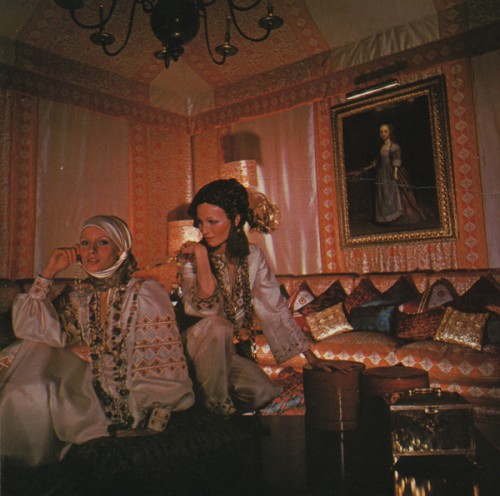
Tent Living: A Delight of Gypsies, 1970
Photographs by Henry Clarke for Vogue UK, March 1970.
Somehow, I’ve drawn all these lines between my brain and my nose and fashion and a character in a book, a series of books, by A.S. Byatt. I don’t know how it happened, but it’s how I connect things I love – the colors, the mood, the feeling. There’s always a literary allusion, an associated smell, a season, a tone. Also, the music. I have to syncretize everything, to draw threads. Only connect. There are certain colors, certain songs, certain scents that I only want to experience in the fall. This is a collection of those things. Even though technically fall should be over by now, in Texas it’s hardly begun. The leaves are finally beginning to turn, and flutter. I don’t even have the heater on. This is the way it goes, down here. Indian summer forever.
In Great British Fashion – Editorial by Norman Parkinson from Vogue UK, September 15, 1970.
I have become obsessed with A.S. Byatt’s quartet of books following the life of Frederica Potter – so much so though that I’ve found myself coming back to them and rereading, getting sucked back into the story, even when I just mean to thumb through searching for a line to reference. I accidentally reread Babel Tower trying to write about L’Autre, which is why I’m only getting this up now that it’s basically December. Ah, books – they do that! Especially these. There’s something about the character of fierce, fox-faced Frederica, gathering conkers in the woods on a country estate, curled up over a book in a Yorkshire winter, battling it out in various courtrooms and classrooms… The four books span a life. I wonder if Byatt’s done, or if she’ll show us an older Frederica? I can’t help hoping that she will. I want to know what happens even later.
“There was a moment during this time, when his face was on hers, cheek on cheek, brow on brow, heavy skull on skull, through soft skin and softer flesh. He thought: skulls separate people. In this one sense, I could say, they would say, I lose myself in her. But in that bone box, she thinks and thinks, as I think in mine, things the other won’t hear, can’t hear, though we go on like this for sixty years. What does she think I am? He had no idea. He had no idea what she was.”
— The Virgin in the Garden, A.S. Byatt
“Hugh says, ‘You’ve done a lot of living, Frederica. Real things have happened to you.’
‘Having things happen to you and living’ says Frederica. She begins again. ‘They aren’t the same thing. I suppose they must be the same thing. I used to be so sure about living. I wanted.’
The sentence has no object and no end, apparently.”
— Babel Tower, A.S. Byatt
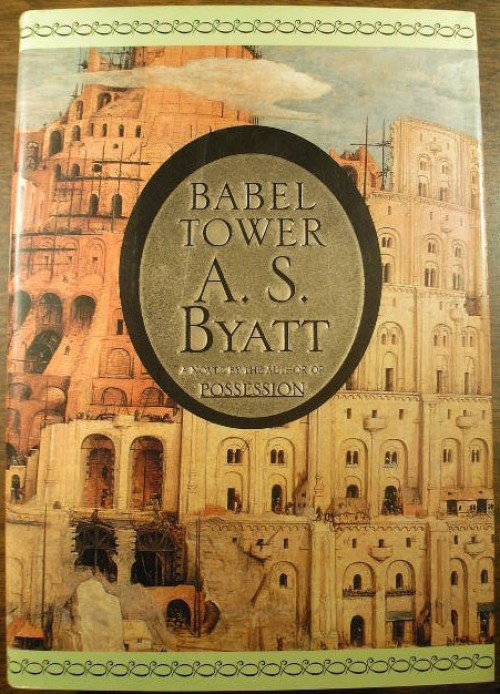
This isn’t my copy, because the cover (and several of the pages) were mauled by my dog awhile back. Again, I refuse to give it up, and still tote around my tattered tome. Like so:
Here’s a few good reviews of the quartet, if you’re curious – but honestly, go read them yourself! They are so beautifully realized. As a finished A Whistling Woman, (which I think is maybe my favorite of the four), I found myself constantly marveling over passages and feeling the intense urge to find and hug A.S. Byatt. She’s such a goddamn wonderful writer.
The Frederica Quartet – Frederica Potter/Alexander Wedderburn – all the beginning there was
Summer Reading: The Frederica Potter Quartet from Marissa Skudlarek
The Books: “Babel Tower” from The Sheila Variations

Vogue UK, May 1975 – via youthquakers
“At the end of the ride, when he comes to it, is a stile. Beyond the stile are rough fields and hedges. On the other side of the stile are a woman and child, standing quietly. The woman is wearing country clothes, jodhpurs, boots, a hacking jacket. She has a green headsquare knotted under her chin, in the style of Queen and her royal sister. She leans on the fence, without putting her weight on it, looking into the wood.”
— Babel Tower
I picture Frederica as looking like a cross between a young Grace Coddington and Tilda Swinton – gingery and sharp angles, with bright inquisitive eyes. Elegant, erudite and oddly elfin.
“There is a dress. It is dark charcoal grey with a high neck and long tight cuffs, woven with red silk braid and embroidery, very rich, very plain. It is a long tunic that goes over a short, slightly flaring skirt. It looks like, it is, Courrèges. Frederica, like most women with red hair, does not wear red, but there is one red, a clear dark vermilion, that brings out the fire in her hair and the gold in her dusting of freckles. This is that red. No one knows what to say.”
“Frederica comes back wearing the dress. In its honor she has put on black tights, and carefully dressed her hair in a chignon. She is beautiful. Frederica is never beautiful, though often alive with attractive energy, but just for the moment, in the Courreges dress, she is wholly beautiful. It is the word. The dress fits almost too perfectly: her small high breasts sit neat and elegant inside its beautiful seams; her thin wrists, her narrow waist, her long thin hips, are beautiful where the silk-lined cloth skims past them, making look like necessary forms in relation to each other. It is a strange style, formal, tailored, severe, ending so far above the knee that the brevity of the skirt should be childish, a gym-slip, a dolly-dress, but it is not.”
There’s a scene in Babel Tower where Frederica’s hair is somewhat brutally styled into a sleek Vidal Sassoon bob. I can’t help thinking that Byatt must’ve been modeling her haircut on Coddington’s. Frederica writes about herself in the third person:
“A woman is sitting in Vidal Sassoon’s salon, the Bond Street one. She is having her long hair, which she has always had, shorn into one of those smooth, swinging cuts, like blades in their precise edges and points. Two young men are working together on the nape of her neck. Her feet are surrounded by shanks and coils and wisps and tendrils of what until recently was her body. It sifts, it is soft, it pricks between her collar and her skin. One man leans over her and holds the two points of her new hair down, dragged down, to her jaw. He hurts her.”
— Babel Tower
Grace Coddington On Vidal Sassoon’s Famous Five-Point Haircut: ‘It gave you a certain freedom’
” Frederica goes to Paddington. She stands under the Departures and Arrivals. Her mouth is dry, her heart bangs audibly, her blood fizzes. She is alone. Her brown shoulder-bag hangs below the hem of her bright green cotton shift, which hugs her buttocks. Her long, thin legs tremble visibly. Her eyes are made up like does’ eyes. She has had her hair cut, finally: it is a shining bronze cap, or helmet, with pointed tongues licking her cheekbones.”
— Babel Tower
One of my favorite things about the quartet is that they contain books within books, stories within stories. There are letters, poems, a fantastic children’s fantasy, an Sadeian allegory, references to politics, events of the time, all the cultural shifts, and especially – the fashion. I love the way Byatt describes what Frederica wears, and even her makeup. It’s important.
Tilda Swinton Covers Candy Magazine
An aside: I restrained myself from buying this insanely expensive, insanely amazing magazine in New York, and I’m still regretting it. Oh, Tilda! Marry me.
CANDY 4. TILDA SWINTON from By Luis Venegas on
Vimeo.

Gayla Milovskaya by Barry Lategan, 1970s
“She wears a black linen shift, well above her knees, and a silk shawl, black, embroidered with creamy cabbagey roses and golden lilies, with a long, shimmering fringe. She has learned to line her eyes with a black, surprised stare, and to lengthen her lashes; nothing can make her angular quickness look doll-like, but this is as near as she will ever get. She has painted her wide mouth creamy brown, a pale colour, which does not wholly suit her.”
— Babel Tower

Photo by Barry Lategan for Vogue UK, June 1972.
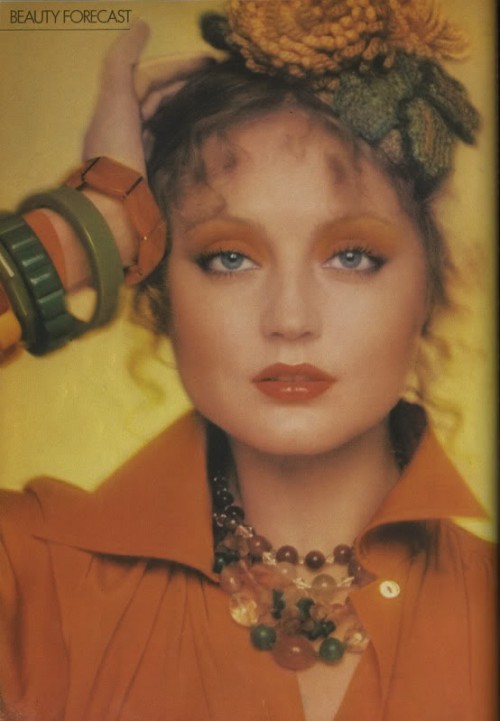
Beauty Babe: Amber and Bronze
Ingrid Boulting by Barry Lategan For Vogue UK, January 1973.

Beauty Babe: Dreamy Summer Solstice
Editorial by Clive Arrowsmith for Vogue UK, April 1971.
So, of course I had to make an accompanying soundtrack to all this:
It’s a mix of new and old psychedelia and music from exotic otherwheres. It’s for putting on the record player while you eat dinner in front of the fire, or drink tea and stare out the window on a bitter cold day, dreaming of far-flung cities, warmer places. It is music for a red-haired woman named Frederica, for a woman made of flame, of white wood. A woman who dreams of traveling the world, but hasn’t quite yet.
For more on my obsession with perfumes for autumn weather: AUTUMNAL PERFUMES


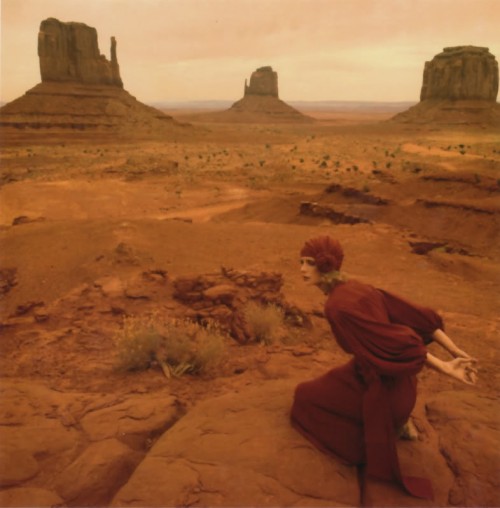
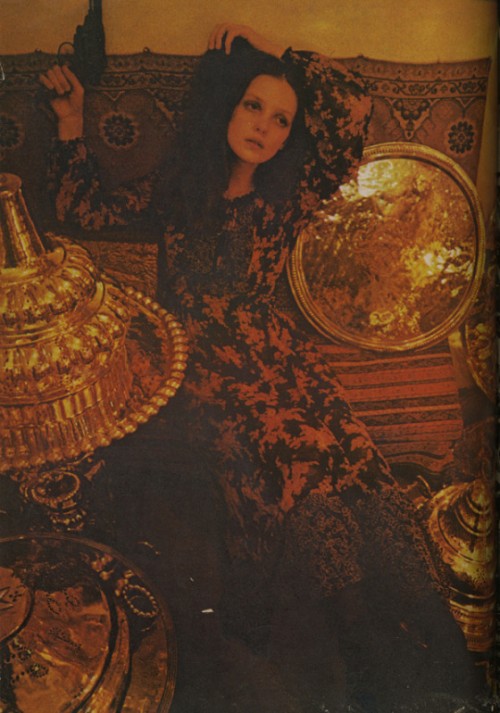
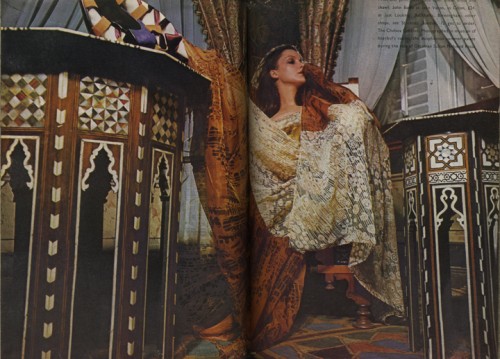




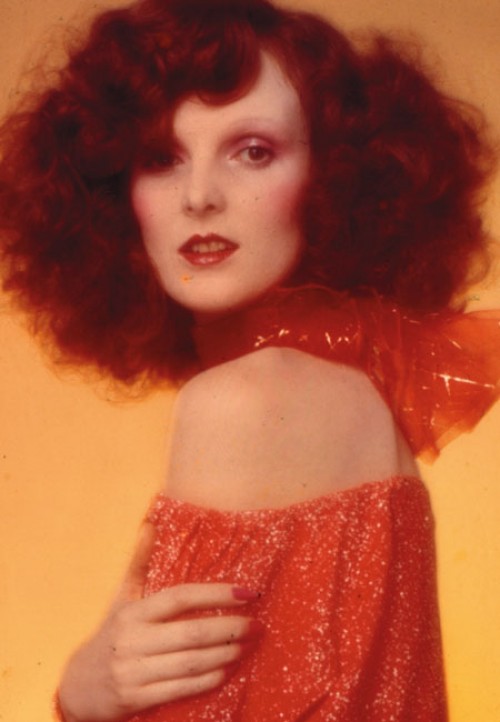

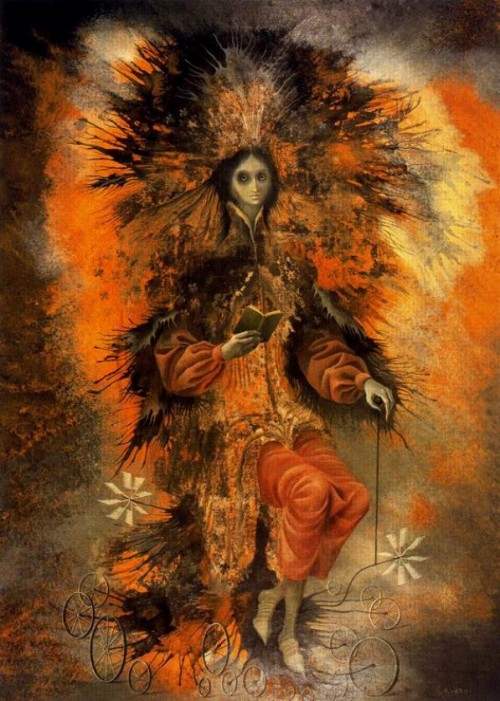
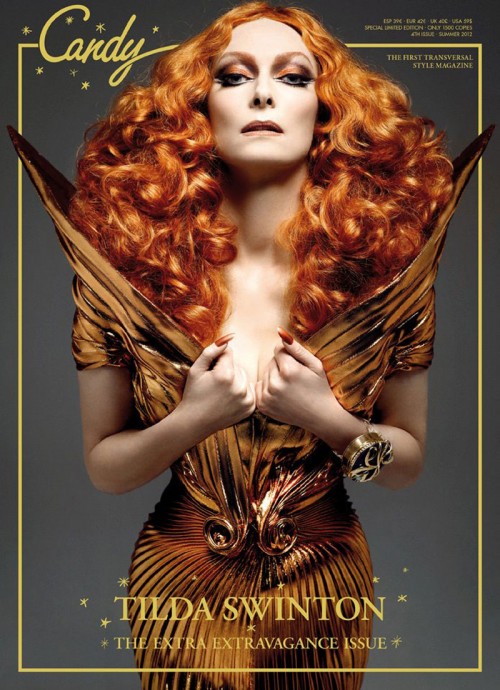

5 comments
Highly recommend “Grace: a memoir” if you havent already read it!
by poutfits on December 1, 2012 at 12:29 am. #
So very much in love with Grace Coddington at the moment. Just dyed my hair a red similar to hers. Looking to welcome the New Year with a new shade of life.
by Christine on December 1, 2012 at 1:35 am. #
I am a natural blonde, but never felt “it”. I have a number of red haired aunts so my coloring is in the ballpark. I went Ginger for almost 15 years, I loved it. You nailed the feeling. It’s earthy, heady and very much the scent of sex from a lost weekend. My favorite scent is Bergamont, sometimes mixed with Cardamom and Neroli. Your sound track is spot on, a recording of the times. I also remember pouring over Vogue and British Vogue. Every issue was majic…a tapestry of a certain lifestyle, a lifestyle I desperatly wanted. Now I have to find a bottle of Diptique’s L’Autre!
by Paula on December 1, 2012 at 3:11 am. #
DAAAAMN! I’ve got to smell that stuff. That sounds like exactly my idea of sexy, right on the nose.
by Leila on December 1, 2012 at 11:49 am. #
Lovely post, making me homesick and timesick! My Venetian friend told me he once took a bunch of flowers for A.S. Byatt at a signing, and commented that she looked like such a typical little old British lady. What hidden depths!
by Emma on December 2, 2012 at 3:06 pm. #